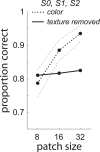Detecting natural occlusion boundaries using local cues
- PMID: 23255731
- PMCID: PMC4504335
- DOI: 10.1167/12.13.15
Detecting natural occlusion boundaries using local cues
Abstract
Occlusion boundaries and junctions provide important cues for inferring three-dimensional scene organization from two-dimensional images. Although several investigators in machine vision have developed algorithms for detecting occlusions and other edges in natural images, relatively few psychophysics or neurophysiology studies have investigated what features are used by the visual system to detect natural occlusions. In this study, we addressed this question using a psychophysical experiment where subjects discriminated image patches containing occlusions from patches containing surfaces. Image patches were drawn from a novel occlusion database containing labeled occlusion boundaries and textured surfaces in a variety of natural scenes. Consistent with related previous work, we found that relatively large image patches were needed to attain reliable performance, suggesting that human subjects integrate complex information over a large spatial region to detect natural occlusions. By defining machine observers using a set of previously studied features measured from natural occlusions and surfaces, we demonstrate that simple features defined at the spatial scale of the image patch are insufficient to account for human performance in the task. To define machine observers using a more biologically plausible multiscale feature set, we trained standard linear and neural network classifiers on the rectified outputs of a Gabor filter bank applied to the image patches. We found that simple linear classifiers could not match human performance, while a neural network classifier combining filter information across location and spatial scale compared well. These results demonstrate the importance of combining a variety of cues defined at multiple spatial scales for detecting natural occlusions.
Figures


















References
-
- Abdou I., Pratt W. (1979). Quantitative design and evaluation of enhancement/thresholding edge detectors. Proceedings of the IEEE , 67, 753–763.
-
- Acharya T., Ray A. K. (2005). Image processing: Principles and applications. Hoboken, NJ: Wiley-Interscience.
-
- Arsenault E., Yoonessi A., Baker C. L. (2011). Higher-order texture statistics impair contrast boundary segmentation. Journal of Vision , 11(10):15 1–15, http://www.journalofvision.org/content/11/10/14, doi:10.1167/11.10.14 [PubMed] [Article] - PubMed
-
- Baddeley R. J., Tatler B. W. (2006). High frequency edges (but not contrast) predict where we fixate: A Bayesian system identification analysis. Vision Research , 46, 2824–2833. - PubMed
-
- Baker C. L., Mareschal I. (2001). Processing of second-order stimuli in the visual cortex. Progress in Brain Research , 134, 1–21. - PubMed
Publication types
MeSH terms
Grants and funding
LinkOut - more resources
Full Text Sources

